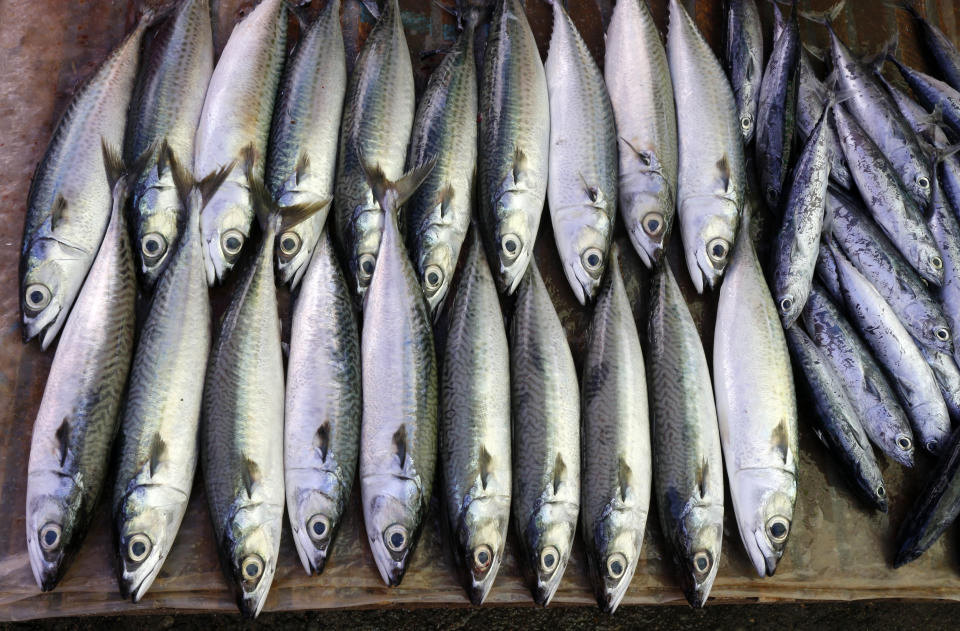Fatty fish are having a moment, after a new study suggested that replacing red meat consumption with forage fish such as sardines and anchovies has the potential to save 750,000 lives.
The study, conducted by a team of Japanese and Australian researchers and published in the journal BMJ Global Health earlier this month, found that eating more fatty fish and cutting back on red meat can dramatically reduce the overall number of deaths from diet related diseases.
This type of fish is a basic element in the Mediterranean and Atlantic diets, in which fish play an important role. They are known to be highly nutritious, as well as environmentally friendly, having one of the lowest carbon footprints of any animal feed source, the researchers noted.
The scientists said in their report: “To improve human health and the health of the planet, we should limit consumption of red meat and move towards foods that are both healthy and environmentally friendly.”
What species of fish are considered fatty fish?
Fish that usually have colored or darker flesh, such as trout, salmon, mackerel, sardines, herring, anchovies and fresh tuna, are considered fatty fish.
Of these, the smaller and cheaper fish such as sardines, mackerel, anchovies and herring are classified as forage fish, meaning they are eaten by larger fish.
What are the nutritional benefits of oily fish?
Lucy Kerrison, consultant dietitian at King Edward VII Hospital, explains that oily fish typically contains high levels of omega-3 fatty acids, which have many benefits.
“Fatty fish contain high levels of omega-3 fatty acids that can reduce inflammation, improve cardiovascular disease and arthritis, and may be protective against cancer and cancer growth,” he tells Yahoo UK.
“Omega-3s play an important role in brain health, eye health, skin health and kidney function. Fatty fish is the only source of eicosapentaenoic acid (EPA) and docosahexaenoic acid (DHA ) based on food, which are the fatty acids that have been shown to have positive biological effects.”
You can get omega-3 fatty acids from plant-based foods, but Kerrison says that while these “can be converted to DHA and EPA,” not all are converted. “So it can be much more difficult to get adequate EPA and DHA without fatty fish in the diet.”
Fatty fish is also a good source of prebiotics that feed the gut microbiome. Kerrison adds that they also “provide protein, as well as essential vitamins and minerals, including vitamin A, B vitamins, D, zinc, iron and selenium.”
How Much Fatty Fish Should You Eat?
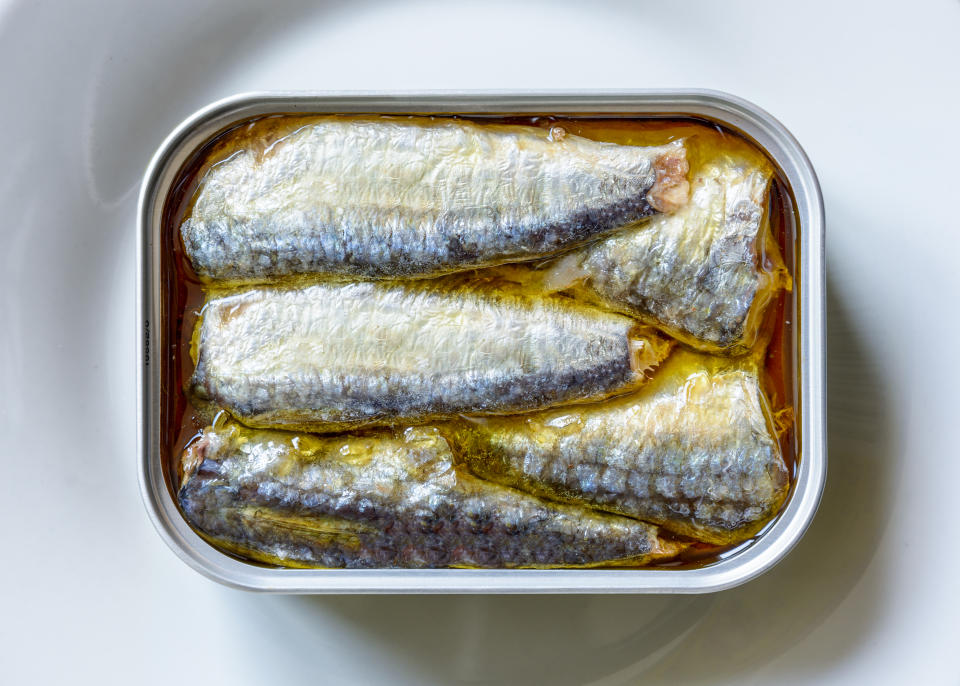
Most people should eat between two and four portions of oily fish per week, with one 140g serving uncooked, advises Kerrison. However, this also depends on your age and lifestyle.
“Girls under 16 and those who are pregnant or planning to become pregnant in the future should eat no more than two servings per week,” she adds.
“This is because the higher levels of pollutants, such as mercury, found in fatty fish can build up in the body and affect a baby’s future development in the womb.”
As for whether we should swap red meat for fatty fish, Kerrison confirms that this is something that would benefit us significantly.
“Processed red meat is associated with bowel cancer and should be minimized in the diet. Lean, unprocessed red meat can be consumed as part of a balanced diet, and I recommend limiting a once a week for the general population,” he says. .
“Increasing fatty fish in the diet and switching from processed and red meat to fatty fish can improve the microbiome, help prevent colon cancer, and can support inflammatory conditions and overall health.”
Fatty fish recipes to cook at home
Aromatic coconut salmon curry from Dominique Woolf
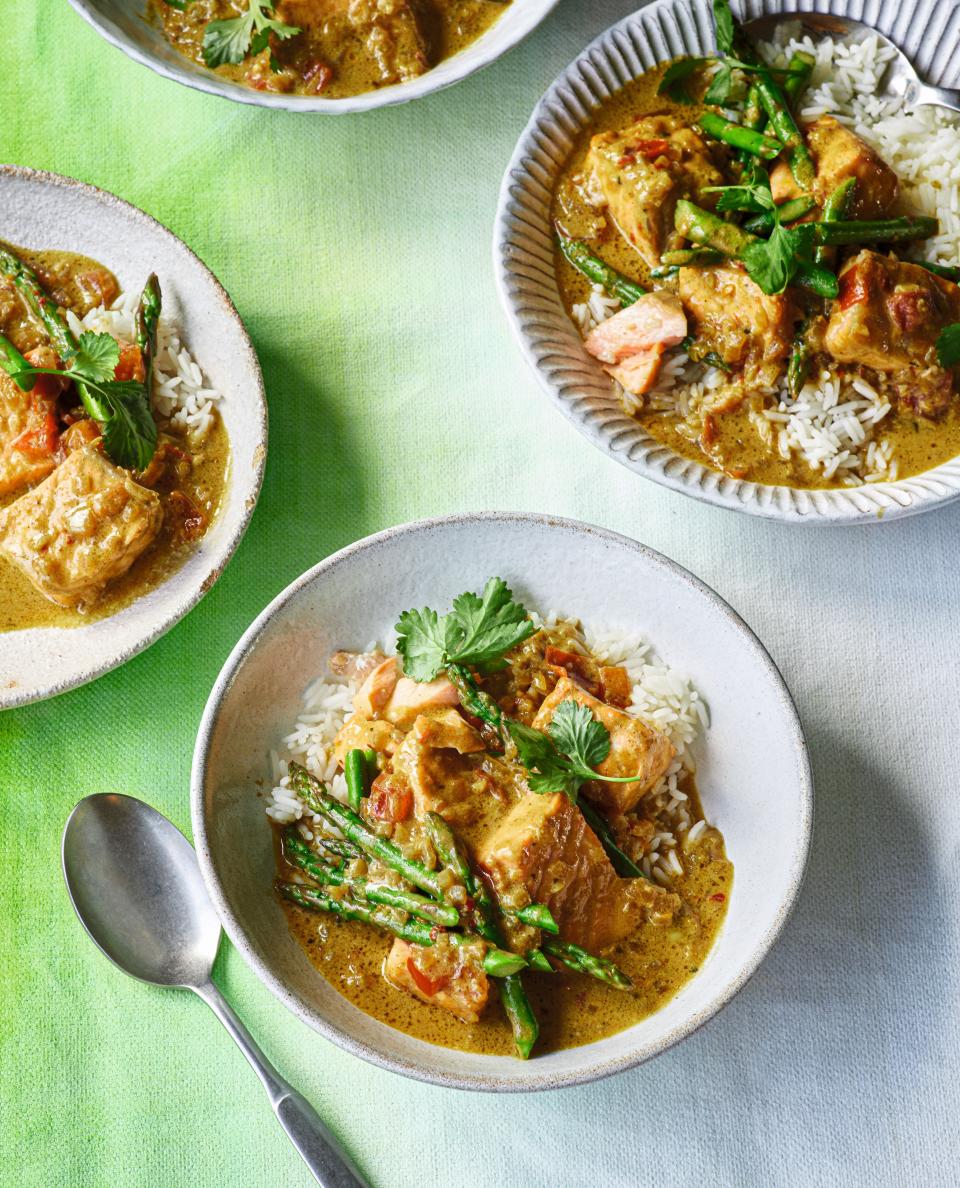
It’s useful: four
Ingredients:
-
1 tablespoon of neutral oil
-
1 onion, finely chopped
-
2 cloves of garlic, finely chopped
-
1 tablespoon grated fresh ginger
-
1/2 teaspoon Chinese five spice
-
1 tablespoon of curry powder
-
1 teaspoon chili flakes (optional)
-
1 medium tomato, chopped
-
1 can of 400 ml coconut milk
-
150 ml of water
-
2 tablespoons of light soy sauce
-
2 teaspoons of sugar
-
4 skinless salmon fillets, about 500 g, cut into 3 cm pieces
-
250 g of asparagus, cut into 3-4 cm pieces
Method:
1. Heat 1 tablespoon of oil in a large pan over medium heat. Add the onion with a pinch of salt and cook for three minutes, stirring occasionally. Add the garlic and ginger, and fry for another two to three minutes, until soft.
2. Add the Chinese five spice, curry powder and chilli flakes and fry for another minute, adding another splash of oil if necessary.
3. Pour in the tomato along with the coconut milk, water, soy and sugar. Increase the heat to medium-high and bring to a boil. Bubble for five minutes, until the sauce thickens a little, then taste the sauce and add soy, salt or sugar as needed.
4. Add the salmon and coat it with the sauce. Reduce the heat to medium and cook for three minutes, stirring and turning the salmon pieces occasionally. Add the asparagus and coat with the sauce, being careful not to break the salmon. Simmer for another two to three minutes, until the salmon and asparagus are cooked through.
5. Serve with rice and/or rolls and sprinkle with coriander leaves.
Pre-order The Asian pantry by Dominique Woolf (Penguin Michael Joseph, 20 June 2024)
Jersey Royal, green vegetables and salmon stew stellar
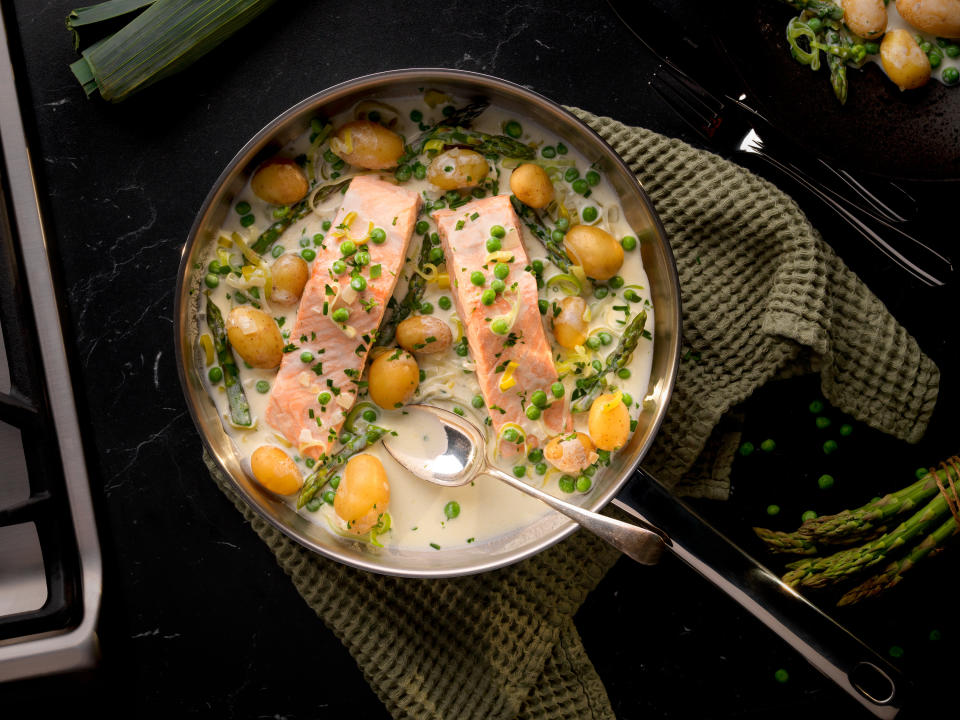
It’s useful: four
Ingredients:
-
2 tablespoons of olive oil
-
2 shallots, finely chopped
-
1 small leek, washed and sliced
-
2 cloves of garlic, peeled and crushed
-
500g Jersey Royal potatoes, scrubbed and cut into chunks if large
-
100 ml dry white wine
-
250 ml of vegetable broth
-
100 ml fresh cream or cream
-
4 salmon fillets
-
125 g of asparagus tips
-
100 g of frozen peas
-
1 small bunch of chives, chopped
-
1 teaspoon of lemon zest
-
Sal
-
pepper
Method:
1. Heat the oil in a pan. Add the shallots, leek and garlic and cook over a low heat until the shallots are soft but not coloured. Add some salt and freshly ground pepper.
2. Add the new potatoes and pour in the wine. Bring to a boil, cook for 2 minutes before adding the stock. Cover the pan with a lid and cook for 10 minutes or until the potatoes are almost cooked.
3. Stir in the cream or cream and place the salmon fillets in the pan, pressing gently. Cover and cook over low heat for 5 minutes.
4. Remove the lid, add the asparagus tips and cook for 2-3 minutes, then add the peas during the last few minutes of cooking.
5. Divide the stew between 4 bowls, sprinkle with the lemon zest and fresh chives.
Grilled mackerel with rhubarb sauce good mom
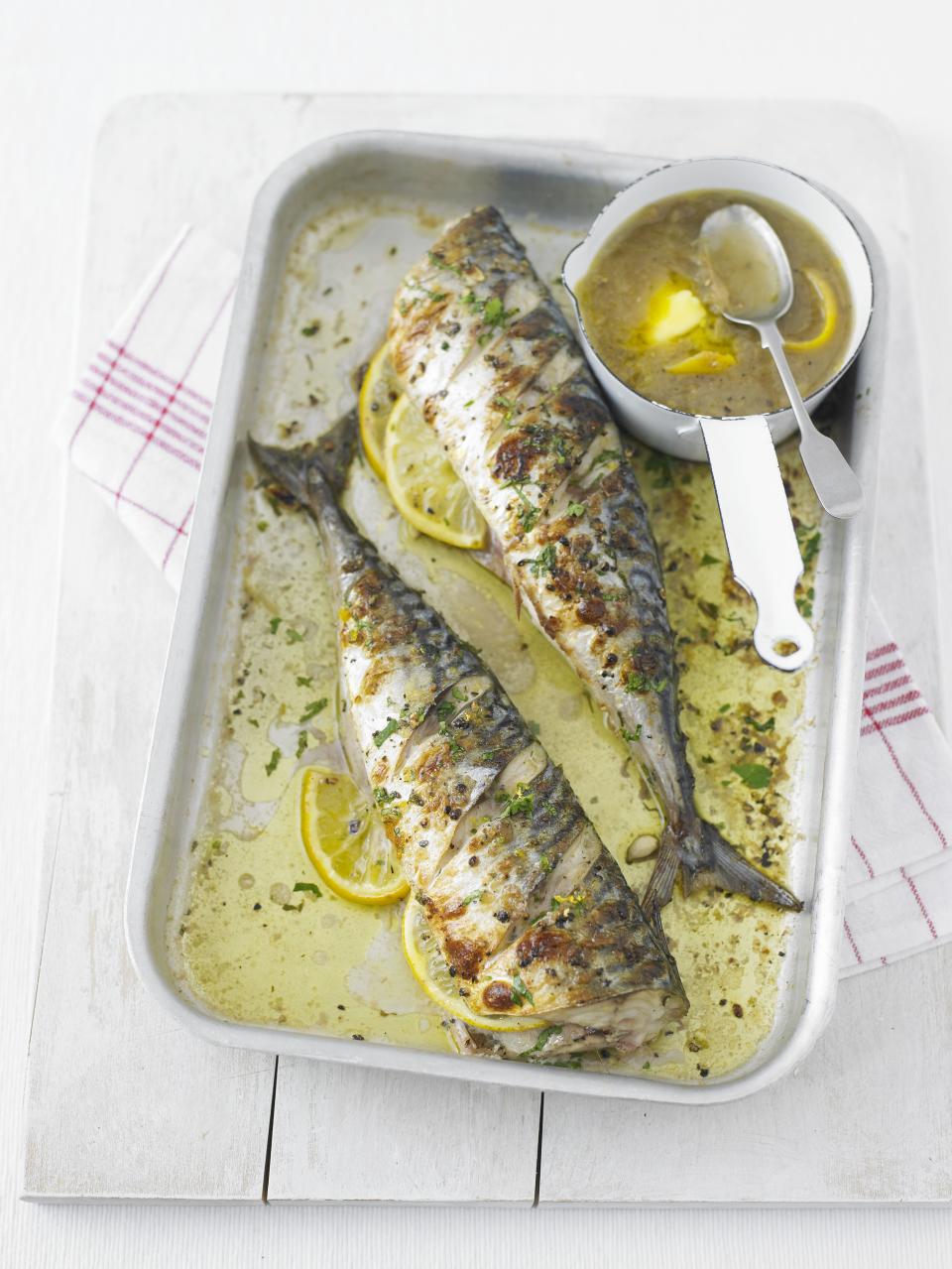
It’s useful: Six
Ingredients:
-
6 fresh mackerel of about 225 g each, gutted and cleaned
-
1 lemon, cut into 12 half slices
-
1.5 lemons without wax, grated and squeezed
-
15 g butter, melted
-
1 tablespoon fresh chopped parsley
-
9 tablespoons of Bonne Maman rhubarb compote
-
3 tablespoons of white wine vinegar
-
1 cm piece of ginger, peeled and sliced
-
Sal
-
Ground white pepper
Method:
1. Place all sauce ingredients in a stainless steel saucepan and heat gently over low heat for 3-5 minutes, until combined and reduced to a coating consistency. Remove from the heat, discard the ginger and leave to cool.
2. Preheat the grill to high heat.
3. Dry the mackerel with kitchen paper. Make 2 or 3 deep cuts in the side of each fish and season the cavities lightly; add 2 half lemon slices to each fish.
4. Place the mackerel in a shallow pan or rimmed baking sheet. Brush both sides with melted butter and season lightly.
5. Reduce the grill to medium heat and cook the fish placed 5-7.5 cm (2-3 inches) from the heat source for 6-8 minutes, then turn it over and do the other side Serve sprinkled with chopped parsley and warm rhubarb sauce.
Read more about food and diets:
#eating #oily #fish #good #cook
Image Source : uk.style.yahoo.com
